纳米罗勒精油/聚乙烯吡咯烷酮
摘要: 罗勒精油(Basil essential oil,BEO)是一种绿色、安全的抑菌剂。然而,BEO的强挥发性限制了其在抑菌伤口敷料领域的应用。本文采用纳米沉淀法制备了纳米罗勒精油(BEO@Zein(玉米醇溶蛋白)),然后将其负载在以聚乙烯吡咯烷酮(PVP)和聚乙烯醇(PVA)为基材的水凝胶上,通过冻融循环形成了BEO@Zein/PVP-PVA水凝胶伤口敷料,对BEO@Zein和水凝胶的微观形貌和结构进行表征,对水凝胶的抑菌性能、力学性能、溶胀保湿性、降解性、血液相容性进行研究。结果表明:BEO@Zein形成了以BEO为核、Zein为壳的纳米球形结构(平均粒径为56.3 nm),显著降低了BEO挥发性。BEO@Zein/PVP-PVA水凝胶可以缓慢释放BEO,从而表现出优异的缓释抑菌性能。因此,BEO@Zein/PVP-PVA水凝胶具有良好的抑菌持久性(超过72 h)。此外,水凝胶还表现出显著的抗细菌生物膜性能。BEO@Zein/PVP-PVA水凝胶的力学性能、溶胀保湿性、降解性和血液相容性均表现良好。研究表明:BEO@Zein/PVP-PVA水凝胶是一种良好的伤口敷料材料。
Abstract: Basil essential oil (BEO) is a green and safe antibacterial agent. However, the high volatility of BEO has limited its application in the field of antibacterial wound dressings. BEO nanoparticles (BEO@Zein) were prepared by nanoprecipitation method. They were then loaded on the hydrogel based on polyvinylpyrrolidone (PVP) and polyvinyl alcohol (PVA) to form BEO@Zein/PVP-PVA hydrogel wound dressing by freeze-thaw cycle. The microscopic morphology and structure of BEO@Zein and hydrogel were characterized. The antibacterial property, mechanical property, swelling and moisturizing, degradability and blood compatibility of hydrogel were studied. The results show that BEO@Zein forms a nano-spherical structure with BEO as core and Zein as shell (mean particle size is 56.3 nm), which significantly reduces the volatility of BEO. BEO@Zein/PVP-PVA hydrogel can release BEO slowly, thus exhibiting excellent slow-release antibacterial property. Therefore, BEO@Zein/PVP-PVA hydrogel has excellent antimicrobial persistence (over 72 h). In addition, the hydrogel shows remarkable antibacterial biofilm property. BEO@Zein/PVP-PVA hydrogel has good mechanical property, swelling and moisturizing, degradability, and blood compatibility. Studies have shown that BEO@Zein/PVP-PVA hydrogel can be used as a good wound dressing material.
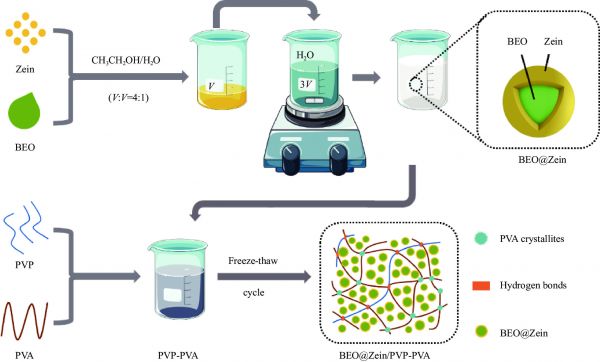
图 1 罗勒精油(BEO)@玉米醇溶蛋白(Zein)/聚乙烯吡咯烷酮(PVP)-聚乙烯醇(PVA)水凝胶的制备示意图
V—Volum
Figure 1. Schematic diagram of basil essential oil (BEO)@Zein/polyvinylpyrrolidone (PVP)-polyvinyl alcohol (PVA) hydrogel preparation
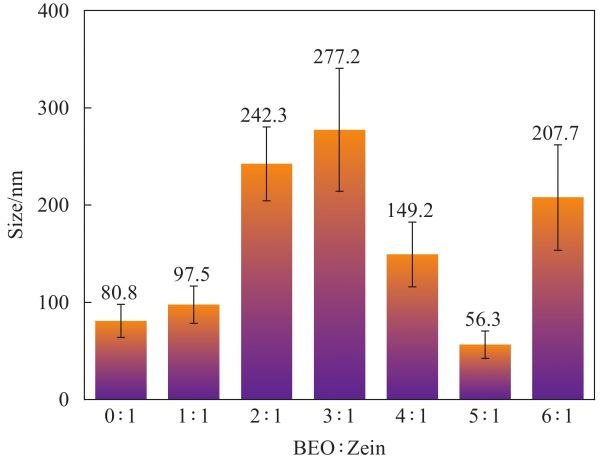
图 2 纳米Zein和不同质量比BEO@Zein纳米粒子的平均粒径
Figure 2. Average particle size of Zein nanoparticles and BEO@Zein nanoparticles with different mass ratios

图 3 纳米Zein和不同质量比的BEO@Zein纳米粒子悬浮液对E. coli和S. aureus的抑菌性
Figure 3. Bacteriostasis of Zein nanoparticle suspensions and BEO@Zein nanoparticle suspensions with different mass ratios against E. coli and S. aureus

图 4 纳米Zein的TEM (a)和SEM图像(c);BEO@Zein的TEM (b)和SEM图像(d);PVA水凝胶(e)、PVP-PVA水凝胶(f)、BEO@Zein/PVP-PVA水凝胶((g), (h))的SEM图像
Figure 4. SEM (a) and TEM (c) images of Zein nanoparticles; SEM (b) and TEM (d) images of BEO@Zein nanoparticles; SEM images of PVA hydrogel (e), PVP-PVA hydrogel (f) and BEO@Zein/PVP-PVA hydrogel ((g), (h))

图 5 水凝胶的FTIR图谱(a)、XRD图谱(b) 、DSC曲线(c)和TG曲线(d)
Figure 5. FTIR spectra (a), XRD patterns (b), DSC curves (c) and TG curves (d) of hydrogel
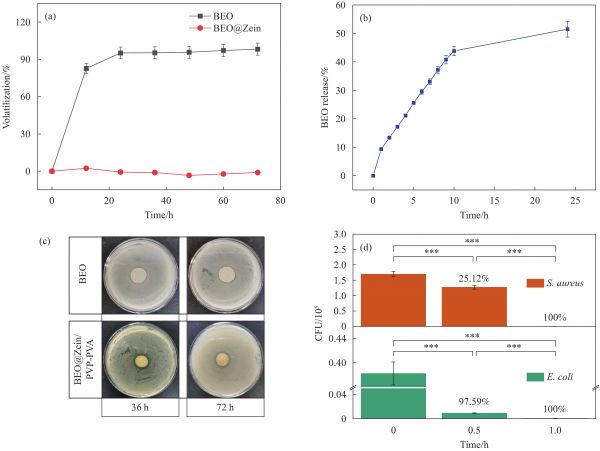
图 6 (a) BEO和BEO@Zein在37℃空气中的挥发率;(b) BEO@Zein/PVP-PVA水凝胶在磷酸盐缓冲溶液(PBS)中对BEO的释放;(c) BEO (以滤纸为载体)和BEO@Zein/PVP-PVA水凝胶在37℃空气中挥发36 h和72 h后对E. coli的抑菌性;(d) BEO@Zein/PVP-PVA水凝胶在模拟体液中释放BEO对E. coli和S. aureus的抑菌性
***—Significant difference (p<0.001, n =3); CFU—Colony forming units
Figure 6. (a) Volatilization ratio of BEO and BEO@Zein in 37℃ air; (b) BEO release of BEO@Zein/PVP-PVA hydrogel in phosphate buffer saline (PBS); (c) Antibacterial activity of BEO (filter paper as carrier) and BEO@Zein/PVP-PVA hydrogel on E. coli after volatilization in 37℃ air for 36 h and 72 h; (d) Bacteriostasis of BEO@Zein/PVP-PVA hydrogel releasing BEO in simulated body fluids on E. coli and S. aureus
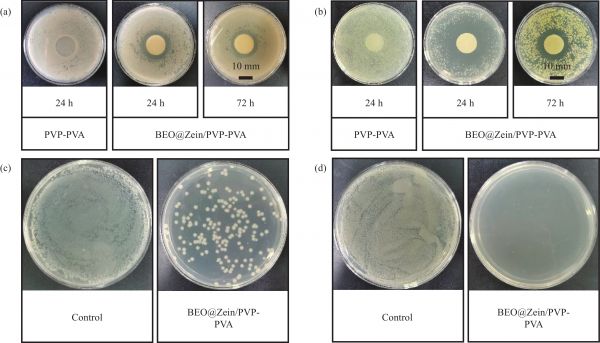
图 7 PVP-PVA水凝胶和BEO@Zein/PVP-PVA水凝胶对E. coli (a)和S. aureus (b)持续抑菌24 h和72 h后的抑菌性;BEO@Zein/PVP-PVA水凝胶抗E. coli生物膜(c)和S. aureus生物膜(d)性能
Figure 7. Antibacterial activity of PVP-PVA hydrogel and BEO@Zein/PVP-PVA hydrogel against E. coli (a) and S. aureus (b) after 24 h and 72 h of sustained bacteriostasis; BEO@Zein/PVP-PVA hydrogel against E. coli biofilms (c) and S. aureus biofilms (d)
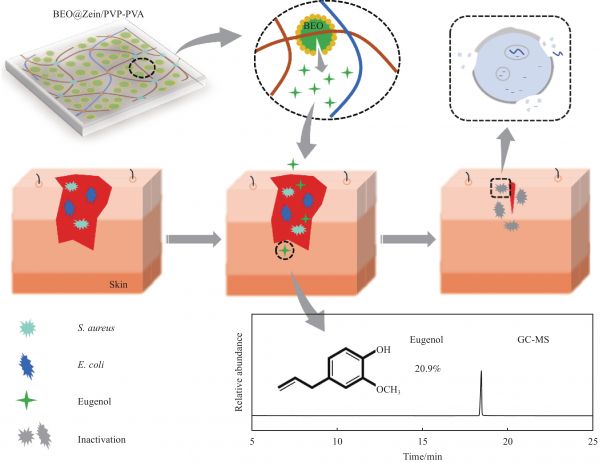
图 8 BEO@Zein/PVP-PVA水凝胶的缓释抑菌机制示意图
Figure 8. Schematic diagram of slow-release bacteriostatic mechanism of BEO@Zein/PVP-PVA hydrogel

图 9 (a) PVA水凝胶、8.5wt%PVA水凝胶、PVP-PVA水凝胶、PVP-8.5wt%PVA水凝胶、BEO@Zein/PVP-PVA水凝胶的应力-应变曲线;(b) PVA水凝胶、PVP-PVA水凝胶、BEO@Zein/PVP-PVA水凝胶在PBS溶液中的溶胀率曲线;(c) BEO@Zein/PVP-PVA水凝胶在37℃和25℃下的失水率曲线;(d) PVP-PVA水凝胶和BEO@Zein/PVP-PVA水凝胶在土壤和PBS溶液中的降解率曲线
Figure 9. (a) Stress-strain curves of PVA hydrogel, 8.5wt%PVA hydrogel, PVP-PVA hydrogel, PVP-8.5wt%PVA hydrogel, and BEO@Zein/PVP-PVA hydrogel; (b) Swelling ratio curves of PVA hydrogel, PVP-PVA hydrogel, and BEO@Zein/PVP-PVA hydrogel in PBS solution; (c) Water loss ratio curves of BEO@Zein/PVP-PVA hydrogel at 37℃ and 25℃; (d) Degradation ratio curves of PVP-PVA hydrogel and BEO@Zein/PVP-PVA hydrogel in soil and PBS solution
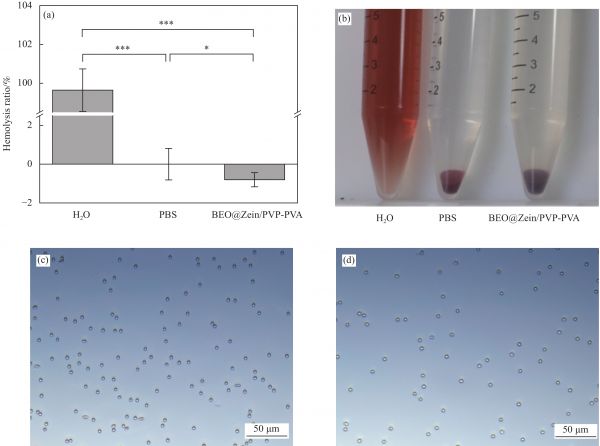
图 10 水、PBS和BEO@Zein/PVP-PVA水凝胶处理的红细胞的溶血率(a)和图像(b);PBS (c)和BEO@Zein/PVP-PVA水凝胶(d)处理的红细胞的光学图像
*—Significant difference (** p<0.01, *** p<0.001, n = 3)
Figure 10. Hemolysis ratio (a) and pictures (b) of red blood cells treated with water, PBS and BEO@Zein/PVP-PVA hydrogel; Optical images of red blood cells treated with PBS (c) and BEO@Zein/PVP-PVA hydrogel (d)
[1]XIONG S, LI R, YE S, et al. Vanillin enhances the antibacterial and antioxidant properties of polyvinyl alcohol-chitosan hydrogel dressings[J]. International Journal of Biological Macromolecules,2022,220:109-116. DOI: 10.1016/j.ijbiomac.2022.08.052
[2]ZHANG Y, JIANG M, ZHANG Y, et al. Novel lignin-chitosan-PVA composite hydrogel for wound dressing[J]. Materials Science and Engineering: C,2019,104:110002. DOI: 10.1016/j.msec.2019.110002
[3]TAO G, WANG Y, CAI R, et al. Design and performance of sericin/poly(vinyl alcohol) hydrogel as a drug delivery carrier for potential wound dressing application[J]. Materials Science and Engineering: C,2019,101:341-351.
[4]BAKADIA B M, ZHONG A, LI X, et al. Biodegradable and injectable poly(vinyl alcohol) microspheres in silk sericin-based hydrogel for the controlled release of antimicrobials: Application to deep full-thickness burn wound healing[J]. Advanced Composites and Hybrid Materials,2022,5(4):2847-2872. DOI: 10.1007/s42114-022-00467-6
[5]KALANTARI K, MOSTAFAVI E, SALEH B, et al. Chitosan/PVA hydrogels incorporated with green synthesized cerium oxide nanoparticles for wound healing applications[J]. European Polymer Journal,2020,134:109853. DOI: 10.1016/j.eurpolymj.2020.109853
[6]SONG S, LIU Z, ABUBAKER M A, et al. Antibacterial polyvinyl alcohol/bacterial cellulose/nano-silver hydrogels that effectively promote wound healing[J]. Materials Science and Engineering: C,2021,126:112171.
[7]WANG Z, WANG Y, PENG X, et al. Photocatalytic antibacterial agent incorporated double-network hydrogel for wound healing[J]. Colloids and Surfaces B: Biointerfaces,2019,180:237-244. DOI: 10.1016/j.colsurfb.2019.04.043
[8]DEDE S, SADAK O, DIDIN M, et al. Basil oil-loaded electrospun biofibers: Edible food packaging material[J]. Journal of Food Engineering,2022,319:110914. DOI: 10.1016/j.jfoodeng.2021.110914
[9]SUN R, SONG G S, ZHANG H, et al. Effect of basil essential oil and beeswax incorporation on the physical, structural, and antibacterial properties of chitosan emulsion based coating for eggs preservation[J]. LWT,2021,150:112020. DOI: 10.1016/j.lwt.2021.112020
[10]MARQUES C S, CARVALHO S G, BERTOLI L D, et al. beta-cyclodextrin inclusion complexes with essential oils: Obtention, characterization, antimicrobial activity and potential application for food preservative sachets[J]. Food Research International,2019,119:499-509. DOI: 10.1016/j.foodres.2019.01.016
[11]LI C Z, BAI M, CHEN X C, et al. Controlled release and antibacterial activity of nanofibers loaded with basil essential oil-encapsulated cationic liposomes against Listeria monocytogenes[J]. Food Bioscience,2022,46:101578. DOI: 10.1016/j.fbio.2022.101578
[12]WEISANY W, YOUSEFI S, TAHIR N A, et al. Targeted delivery and controlled released of essential oils using nanoencapsulation: A review[J]. Advances in Colloid and Interface Science,2022,303:102655. DOI: 10.1016/j.cis.2022.102655
[13]LAMMARI N, LOUAER O, MENIAI A H, et al. Encapsulation of essential oils via nanoprecipitation process: Overview, progress, challenges and prospects[J]. Pharmaceutics,2020,12(5):431. DOI: 10.3390/pharmaceutics12050431
[14]GHORBANI M, HASSANI N, RAEISI M. Development of gelatin thin film reinforced by modified gellan gum and naringenin-loaded Zein nanoparticle as a wound dressing[J]. Macromolecular Research,2022,30(6):397-405. DOI: 10.1007/s13233-022-0049-1
[15]SANKARGANESH P, PARTHASARATHY V, KUMAR A G, et al. Preparation of cellulose-PVA blended hydrogels for wound healing applications with controlled release of the antibacterial drug: An in vitro anticancer activity[J]. Biomass Conversion and Biorefinery, 2022, 4: 1-11.
[16]YU Y, YANG Z, REN S, et al. Multifunctional hydrogel based on ionic liquid with antibacterial performance[J]. Journal of Molecular Liquids,2020,299:112185. DOI: 10.1016/j.molliq.2019.112185
[17]QING X, HE G, LIU Z, et al. Preparation and properties of polyvinyl alcohol/N-succinyl chitosan/lincomycin composite antibacterial hydrogels for wound dressing[J]. Carbohydrate Polymers,2021,261:117875. DOI: 10.1016/j.carbpol.2021.117875
[18]YU H, KIM J S, KIM D W, et al. Novel composite double-layered dressing with improved mechanical properties and wound recovery for thermosensitive drug, lactobacillus brevis[J]. Composites Part B: Engineering,2021,225:109276. DOI: 10.1016/j.compositesb.2021.109276
[19]GUO Y Q, AN X L, FAN Z J. Aramid nanofibers reinforced polyvinyl alcohol/tannic acid hydrogel with improved mechanical and antibacterial properties for potential application as wound dressing[J]. Journal of the Mechanical Behavior of Biomedical Materials,2021,118:104452. DOI: 10.1016/j.jmbbm.2021.104452
[20]THONGSUKSAENGCHAROEN S, SAMOSORN S, SONGSRIROTE K. A facile synthesis of self-catalytic hydrogel films and their application as a wound dressing material coupled with natural active compounds[J]. ACS Omega,2020,5(40):25973-25983. DOI: 10.1021/acsomega.0c03414
[21]GHEORGHITA D, GROSU E, ROBU A, et al. Essential oils as antimicrobial active substances in wound dressings[J]. Materials,2022,15(19):6923. DOI: 10.3390/ma15196923
[22]TEODORESCU M, BERCEA M, MORARIU S. Biomaterials of PVA and PVP in medical and pharmaceutical applications: Perspectives and challenges[J]. Biotechnology Advances,2019,37(1):109-131. DOI: 10.1016/j.biotechadv.2018.11.008
[23]ZHANG H, TANG N, YU X, et al. Natural glycyrrhizic acid-tailored hydrogel with in-situ gradient reduction of AgNPs layer as high-performance, multi-functional, sustainable flexible sensors[J]. Chemical Engineering Journal,2022,430:132779. DOI: 10.1016/j.cej.2021.132779
[24]HE Q, ZHANG L G, SONG L Y, et al. Inactivation of Staphylococcus aureus using ultrasound in combination with thyme essential oil nanoemulsions and its synergistic mechanism[J]. LWT,2021,147:111574. DOI: 10.1016/j.lwt.2021.111574
[25]SHAREEF S N, MADHURI W. Structural, morphological, dielectric and tensile properties of BaTiO3-doped PVA/PVP polymer blend nanocomposites[J]. Polymer Bulletin,2022,80(3):2389-2412.
[26]EL-KADER M F H A, ELABBASY M T, ADEBOYE A A, et al. Nanocomposite of PVA/PVP blend incorporated by copper oxide nanoparticles via nanosecond laser ablation for antibacterial activity enhancement[J]. Polymer Bulletin,2021,79(11):9779-9795.
目的
罗勒精油(Basil essential oil,BEO)是一种绿色、安全的抑菌剂。然而,BEO的强挥发性导致它不能在较长时间内维持抑菌活性,从而限制了其在抑菌伤口敷料领域的应用。本文采用纳米沉淀法在乙醇水溶液中使用两亲性玉米醇溶蛋白(Zein)制备了纳米罗勒精油(BEO@Zein),然后将其负载在以聚乙烯吡咯烷酮(PVP)和聚乙烯醇(PVA)为基材的水凝胶上,通过冻融循环形成了BEO@Zein/PVP-PVA水凝胶伤口敷料,并对BEO@Zein和BEO@Zein/PVP-PVA水凝胶进行表征分析和性能研究。
方法
首先通过扫描电镜(SEM)、透射电镜(TEM)、红外(FTIR)、差式扫描量热法(DSC)、热重(TG)和X射线衍射(XRD)对BEO@Zein和BEO@Zein/PVP-PVA水凝胶进行表征分析。然后以大肠杆菌()和金黄色葡萄球菌()为典型,通过抑菌圈和平板计数法探究BEO@Zein/PVP-PVA水凝胶对BEO的释放对其抑菌性能的影响。使用万能试验机进行拉伸实验探究BEO@Zein/PVP-PVA水凝胶的力学性能。根据质量变化探究BEO@Zein/PVP-PVA水凝胶的溶胀保湿性以及在土壤和PBS溶液中的降解性。用BEO@Zein/PVP-PVA水凝胶处理红细胞,根据溶血率和细胞形态来评价其血液相容性。
结果
SEM和TEM表明,BEO@Zein形成了以BEO为核、Zein为壳的纳米结构,其形貌为规则的球形,当BEO和Zein的质量比为5:1时,平均粒径相对较小(56.3nm)。抑菌实验表明,随着BEO的比例增大,BEO@Zein的抑菌性能也有所提高。SEM还表明,BEO@Zein/PVP-PVA水凝胶具有多孔结构,其表面分布了少量BEO@Zein。FTIR证明了BEO@Zein/PVP-PVA水凝胶的组成以及氢键的存在。XRD表明,BEO@Zein/PVP-PVA水凝胶中形成了PVA结晶的网络结构,且PVA含量越高,PVA结晶性越好,水凝胶交联度就越高。DSC和TG表明,BEO@Zein的核壳结构和BEO@Zein/PVP-PVA水凝胶网络都有利于提高BEO的热稳定性。在挥发性实验中,12h后BEO的挥发率为83%,BEO@Zein的挥发率仅为2%;在模拟体液中,BEO@Zein/PVP-PVA水凝胶中的BEO前10h内呈现近乎线性的释放规律,释放率最高达到44%,与没有氢键作用的BEO相比,该水凝胶体现出对BEO缓慢释放的特性,也因此使得水凝胶具有了持续抑菌的性能。抑菌实验表明,BEO在挥发36h后失去抑菌性,但同一时间下BEO@Zein/PVP-PVA水凝胶仍具有抑菌性,且挥发72h后还有明显的抑菌圈;在模拟体液中BEO@Zein/PVP-PVA水凝胶0.5h后对和的抑制率分别为97.59%和25.12%,1h后抑制率均为100%,证明水凝胶具有缓释抑菌性能,且抑菌实验表明持续抑菌时间超过72h。BEO@Zein/PVP-PVA水凝胶还可以抑制和形成的生物膜,对生物膜的抑制率可以几近达到100%。此外,BEO@Zein/PVP-PVA水凝胶对的抑菌效果比好,这可能是因为BEO中丁香酚等疏水化合物能与细胞膜直接相互作用,而亲水细胞膜会阻碍疏水化合物的渗透,因此对BEO的抵抗力更强。拉伸应力应变曲线表明,在PVA水凝胶中引入PVP可以改善其力学性能,且水凝胶中PVA含量越高,PVA结晶性越好,力学性能越强,BEO@Zein/PVP-PVA水凝胶的拉伸强度和断裂伸长率分别为0.33MPa和402.52%。溶胀率曲线表明,PVA水凝胶、PVP-PVA水凝胶和BEO@Zein/PVP-PVA水凝胶对PBS溶液的吸收在8h后基本饱和,溶胀率分别达到229%、285%和332%以上。失水率曲线表明,BEO@Zein/PVP-PVA水凝胶在25℃和37℃下8h内的失水率分别达到40%和85%以上。在相同时间内,BEO@Zein/PVP-PVA水凝胶的溶胀率要远高于失水率,因此该水凝胶可以通过吸收伤口渗出液维持伤口环境湿润,从而具有溶胀保湿性。降解率曲线表明,PVP-PVA水凝胶和BEO@Zein/PVP-PVA水凝胶的降解率在10天后分别为20%和50%,这是因为BEO@Zein/PVP-PVA水凝胶的PVA含量低于PVP-PVA水凝胶,水凝胶中PVA含量越低,PVA结晶性越差,水凝胶交联度越小,所以降解性越好。BEO@Zein/PVP-PVA水凝胶处理的红细胞的溶血率基本为0,光学图像也显示,细胞形态没有发生明显转变,表明该水凝胶具有血液相容性。
结论
BEO@Zein能提高BEO的热稳定性,并降低其挥发性。BEO@Zein/PVP-PVA水凝胶伤口敷料可以缓慢释放BEO,从而表新出缓释抑菌性能。此外,水凝胶还表现出显著的抗细菌生物膜性能,对生物膜的抑制率几近达到100%。BEO@Zein/PVP-PVA水凝胶以PVA结晶和氢键交联,具有较好的力学性能,同时多孔结构使其具有较强的溶胀保湿性,此外在土壤和PBS中具有降解性。BEO@Zein/PVP-PVA水凝胶伤口敷料处理过的红细胞的溶血率基本为0,细胞也没有发生形态学转变,具有血液相容性。总之,BEO@Zein/PVP-PVA水凝胶是一种有潜力的伤口敷料材料。
相关知识
罗勒精油提取(罗勒精油萃取方式)
甜罗勒精油 罗勒油|8015
甜罗勒精油
三氯乙烯 CAS#: 79
罗勒精油的世界探秘
罗勒精油(罗勒精油——功效全面的)
罗勒精油( Basil)
罗勒精油的功效与作用及禁忌(罗勒精油的化学成分)
常用精油:罗勒
罗勒精油成分鉴定及抑菌活性测定
网址: 纳米罗勒精油/聚乙烯吡咯烷酮 https://m.trfsz.com/newsview853624.html